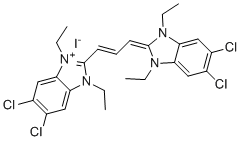All AbMole products are for research use only, cannot be used for human consumption.

Jc-1 (Mitochondrial membrane potential probe) is a fluorescent lipophilic carbonyl cyanine dye used to measure mitochondrial membrane potential. The maximum excitation/emission wavelength is 515nm/529nm (590nm), and green fluorescence is emitted. Used to observe mitochondria, stored at room temperature, away from light. Jc-1 should be redissolved in high-quality freshly opened DMSO (1 mg/mL). After redissolution, it should be stored at -20°C; Avoid freeze-thaw.

Int Immunopharmacol. 2023 Sep 21;124(Pt B):110963.
BNTA attenuates temporomandibular joint osteoarthritis progression by directly targeting ALDH3A1: An in vivo and in vitro study
JC-1 purchased from AbMole

Life Sci. 2021 Jan 15;265:118853.
Circadian clock gene BMAL1 reduces urinary calcium oxalate stones formation by regulating NRF2/HO-1 pathway
JC-1 purchased from AbMole
| Molecular Weight | 652.23 |
| Formula | C25H27Cl4IN4 |
| CAS Number | 3520-43-2 |
| Solubility (25°C) | DMSO ≥ 10 mg/mL |
| Storage | -20°C, protect from light, dry, sealed |
| Related Fluorescent Dye Products |
|---|
| DSPE-Rhodamine
DSPE-Rhodamine is formed by the conjugation of DSPE with the Rhodamine fluorescent dye. DSPE possesses a hydrophobic lipid tail and a hydrophilic head group, while Rhodamine is a red fluorescent dye. DSPE-Rhodamine retains the lipid properties of DSPE while also imparting fluorescent labelling capabilities. As a key component of delivery systems, DSPE-Rhodamine enhances targeting and bioavailability. Its lipid properties facilitate the penetration of molecules through cell membranes, while its fluorescent properties enable tracking of distribution and dynamic changes within the body. |
| LD540
LD540 is a novel high-sensitivity lipophilic dye modified with BODIPY fluorescent groups, designed for precise labelling and imaging of lipid droplets. LD540 exhibits excellent photostability and an optimal fluorescence spectrum, making it compatible with various commonly used fluorescent dyes (such as DAPI and Alexa Fluor 647), thereby supporting multi-colour imaging requirements. Additionally, LD540 is suitable for both fixed and live cells and can label ultra-small lipid droplets. |
| PDMPO
PDMPO (Yellow/Blue DND-160) is a ratiometric probe for the determination of lysosomal pH for fluorescence imaging. PDMPO exhibits pH-dependent dual excitation and dual emission peaks. PDMPO produces blue fluorescence (Ex/Em=329 nm/440 nm) in weakly acidic organelles, and in more acidic lysosomes it becomes yellow fluorescence (Ex/Em=384 nm/540 nm). |
| Copper probe CF4
Copper probe CF4 (Copper fluor CF4) is a Cu+-specific fluorescent probe based on a rhodol dye scaffold. Copper probe CF4 (Copper fluor CF4) has high copper selectivity with a Kd value of 2.9×10-13 M, particularly over zinc and iron, as well as abundant cellular alkali and alkaline earth metals. Copper probe CF4 (Copper fluor CF4) is stable in a physiologically relevant pH regime between 6 and 8 (wavelengths of 415 nm for excitation and 660 nm for emission). Copper probe CF4 (Copper fluor CF4) can be used to study colon cancer. |
| Phalloidin-Fluor 647 Conjugate
Phalloidin-Fluor 647 Conjugate selectively binds to F-actins. Used at nanomolar concentrations, phalloidin derivatives are convenient probes for labeling, identifying and quantitating F-actins in formaldehyde-fixed and permeabilized tissue sections, cell cultures or cell-free experiments. |
All AbMole products are for research use only, cannot be used for human consumption or veterinary use. We do not provide products or services to individuals. Please comply with the intended use and do not use AbMole products for any other purpose.


Products are for research use only. Not for human use. We do not sell to patients.
© Copyright 2010-2024 AbMole BioScience. All Rights Reserved.
